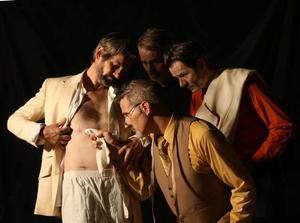The act of believing happens generally through a process. While faith is a gift, rarely does it occur without evidence for we skeptical human beings.
Please listen to the sermon rather than read it. The delivered sermon is often considerably different than the sermon notes which are included for convenience below.
Sermon delivered at Lutheran Church of the Cross in Berkeley.
April 3, 2016 - Second Sunday in Easter
"Coming to Believe". Text is from John 20:19-31

Jesus tells us, "blessed are those who believe without seeing." But who is he referring to? It is certainly nice to think that he may be referring to us, here in the 21st century, because we know for certain it was meant in contrast to how Thomas came to believe that Jesus has risen.
The question for Thomas is why did he happen to miss the resurrection? Why was he out that first Sunday gathering after the resurrection, when all the other disciples were gathered together. Why is it that once Easter comes, so many people decide to take the next week off? Was the resurrection so much that it will last us for weeks at a time? Because every time we come to the table at Eucharist, we gather in memory of the resurrection because it is Jesus himself that we, the body of Christ ourselves, take into us, and his reborn nature inspires us to continue on in our lives. Every Sunday is a resurrection!

But the nature of faith and doubt, which, when we think ab out Thomas, can be a long conversation, may not be entirely resolved by this reading. As I said, this first Sunday of easter when the diciples gather behind locked doors may be considered the first church service, and the basis of today's worship. And Thomas, who gets numerous mentions in the gospels, had not shown up for whatever reason.
And Christ literally is standing among them, and says, "Peace be with you." We assume at that point the other disciples automatically said, "And also with you." If they were not dumbstruck by this man suddenly appearing among them. And we know they do not recognize him at once, because he has to show them his wounds. It is not until that point, not after he appears, not after he speaks, but after they see his wounds that they know it is their teacher, they know it is their master, who stands in their midst.
And what else can they do but rejoice and give glory to God, because their beloved rabbi is among them once again. He who was dead is now with them. And he delivers the Holy Spirit to them, so that they may themselves be able to forgive sins in his name, as disciples of Christ. And how could the disciples not believe.
But when they run into Thomas, he is nevertheless skeptical. He was not fortunate enough to happen to be at that place where Jesus appeared, for whatever reason, not privileged enough to see Jesus in the flesh that first time. We don't know where Thomas was. He's called "the Twin", which is a literal translation of where the name Thomas comes from (we also see references to him as Judas who is called Thomas), but it may be simply a nickname given to him because he resembled someone else. There has been some historical speculation that he looked a lot like Jesus and he earned the nickname from them at that time. So maybe he had to go into deeper hiding than the rest because of it?
And I have never been comfortable referring to him as "Doubting Thomas" as he has been popularized, because that is certainly not a fair assessment of who he is. Maybe the other disciples are pulling a fast one on him? Having a joke at his expense? It's been a rather traumatic week for him and the rest of them, after all, emotions are high. People can refuse to believe a great deal of things under stressful conditions.
It's really not fair to Thomas to convict him amid all the other disciples because he was not fortunate or privileged enough to have been with the rest, and that he calls into question what the other disciples saw. And yet, he did make the following gathering, a week later. He appeared in church. Despite his skepticism, despite his misgivings, he still wanted to give their words a chance. And in doing so, a miracle happens. Jesus does show up. Thomas is offered a chance to put his hand on Jesus wound, like he declared. But of course, despite his declaration, he doesn't need to do that. All he needs is for Jesus to speak to him and be present for him to believe.
No real additional requirement than any of the other disciples. Because as we read in our text, they all had the opportunity to see him and sit with him and enjoy his presence, some few last times. First Mary, and then Peter and the disciple who Jesus loved, then eight other apostles, and then Thomas. None of them believed without seeing.
So who is Jesus talking to when he says, "Blessed are they who have not seen and yet have come to believe"? Scholars have often pointed to the witnesses who came later. First the readers of John's gospel, who knew the names that were written down in them, either by stories or firsthand knowledge, and then the generations of believers who came later on, after the events of the gospels.
However, two thousand years later, we see Jesus in the sacraments every Sunday. We see Jesus in the body of the church gathering as a whole. We see Jesus in the examples we live for one another. So how can it be said that we who believe do so without actually having seen Jesus? Those of us who come to believe do so with a faith gifted to us by God in which we are able to witness the good news of Jesus on a regular and ongoing basis.
So what is Jesus telling Thomas when he says "blessed are those who have not seen and yet have come to believe?" What is this amazing miracle being proclaimed in the telling of those words?
I know many of us are familiar with the words of the 2nd Step of Alcoholics Anonymous, adopted for many other 12-step programs throughout the world. For everyone else, it goes like this: "We came to believe that a power greater than ourselves could restore us to sanity." The steps work in such a manner that we have to first acknowledge that we have a problem and then we have to acknowledge it's not a problem we can solve by ourselves. But how people come to believe may be vastly different for some people than it is for others. And I think it must be an amazing thing for someone to simply believe that this change can come across them without seeing evidence of it in others, but for me and just about anyone else I have ever spoken with, that belief system, that of coming to believe a power greater than one's self can restore one's own self to a sanity that one simply had, is based on a witness of the world around us that we see change and save lives.
But the 12 steps are written as a simple guide for complicated people. Because most of us are natural skeptics. We prefer the evidence of our own experience rather than simply taking other people's words for face value. Because if you look at the reality of our faith. Let us pretend, for a moment, that you lived in a world without any knowledge of Jesus Christ or Christianity. Let us pretend you are the last person on who has ever read scripture and been baptized and taken communion. Let us pretend there are no bibles anymore. Let us think about how one would go about explaining that God made himself was a man who walked the earth two thousand years earlier, and then suffered and died in the most humiliating and shameful way possible in order to defeat death, the devil and the power of the grave, and then, against all odds, rose up again and visited people, performed miracles and left their presence to rule over them from heaven until he will be coming again.
I have to wonder if in those circumstances, even if you were an extremely and powerfully persuasive person, such a story would be laughed at in pretty much every circumstance, because without seeing the evidence of Jesus Christ there in your midst, it really sounds like an incredible and far-fetched story to begin with. People would look at you and wonder why you would even make up such a tale? One would have to indeed be truly blessed to have a gift of simply being able to believe it.
But we are blessed in other ways, my sisters and brothers. We have the privilege of the church and the great cloud of witnesses over the centuries who have shown that Christ is in the world, that Christ lives among us, that miracles happen each and every day, if one only knows where to look. And by that very same miracle of the gift of faith that God has given us through that incredible story of death and resurrection, we are able to witness him on our own, in those ways that we witness him, in the world among each other, in the power of the church, in the sacrament of wine and bread at the table...we see Christ.
Because ultimately it is not how we come to believe in Christ, because Thomas and the disciples and everyone who saw him appear in their presence believed nevertheless. And as the evangelist wrote, we come to believe in order that we may have new life in God. And the good news is that in this process of coming to believe we may have the sanity of our right relationship with God restored to us, and live in wholeness, in new life with God, freed by His blood from our sins, miracles of his Holy Spirit, and saints in the new heaven and new earth yet to come.
Amen.

